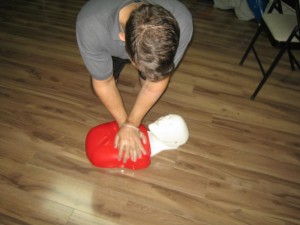CPR and basic first aid is a life-saving procedure that includes giving rescue breaths and chest compressions to causalities suffering from cardiac arrest. CPR helps provide a small quantity of oxygen and blood movement that delays brain injury until regular heart function is restored with advance life support. All medical experts must be qualified in CPR, though non-health employees should study CPR, too, to help protect lives in unexpected circumstances.
Step 1
Check the scene to make certain the situation is safe to approach before giving CPR to the casualty. If there are onlookers, tell somebody nearby to phone for an ambulance straightaway. Roll the casualty softly onto his back if he is lying on the side or on his belly. Tap the casualty on the shoulder and ask if he is okay.
Step 2
Kneel down next to the casualty’s head. Take the palm of your one hand and place it over the center of the casualty’s chest. Take your other hand and place it on top of the first hand. Make sure your elbows are straight and place your shoulders above your hands. Thrust down into the casualty’s body by means of your upper body, not your arms. Perform at least 2 inches of chest compressions at a rate of 100 compressions every minute.
Step 3
Observe the casualty’s airway by putting your palm on his temple and softly leaning the head back after doing the 30 chest compressions. Tilt the jaw forward to expose the airway with your other hand. Look to see if there’s breathing – do this for about 10 seconds. Look for any chest movement or place your ear near the mouth and nose to feel if there is any air.

Step 4
Start rescue breathing if you can’t see any signs of normal breathing. Squeeze the casualty’s nostril closed, and position your mouth entirely over the casualty’s mouth; no air should seep out. Provide two rescue breaths by blowing air into the casualty’s mouth, and look if the chest is moving. Do 30 compressions once you have done the rescue breathing. Redo steps 2 and 4 until the casualty continues breathing normally or until medical help arrives.
Tips
- The Good Samaritan rule safeguards CPR givers against grievances from the casualty or the casualty’s relatives as long as you act in good faith for the casualty.
- Never, ever put yourself at risk! Even though this seems to lack empathy, keep in mind that being a hero means nothing if you end up dead.
- Moving a casualty with spinal injury might increase the possibility of death.
- Do not shift the casualty. It could hurt them even more; except if they are in direct danger. Wait for the medics to get there.
